After three years of pressurized progress at Geauga Lake, its still-new owners – Premier Parks – joined in the ’90s race to consolidate, acquire, and brand amusement parks across the globe.

On April 1, 1998, for an eye-watering $1.86 billion, the upstart and ambitious Premier Parks purchased Six Flags Inc. from its parent company, Time Warner. The massive acquisition added Warner’s eight existing parks (Six Flags Over Texas, Over Georgia, Over Mid-America, AstroWorld, Great Adventure, Magic Mountain, Great America, and Fiesta Texas) to Premier’s (whose portfolio now surpassed two dozen parks worldwide).
Having amassed the world’s largest amusement park collection in the scope of about five years, Premier Parks now faced a branding conundrum: how to unite its legacy parks with the much more recognizable Six Flags brand it had acquired. In 1998, the company rolled out the “Six Flags” prefix to Kentucky Kingdom, Marine World, Darien Lake, and Elitch Gardens. At the same time, Maryland’s Adventure World was renamed Six Flags America.
In 2000, Premier Parks fully renamed itself as SIX FLAGS INC., rolling out the branding to the last of its legacy park holdouts… including Geauga Lake.
Six Flags Ohio
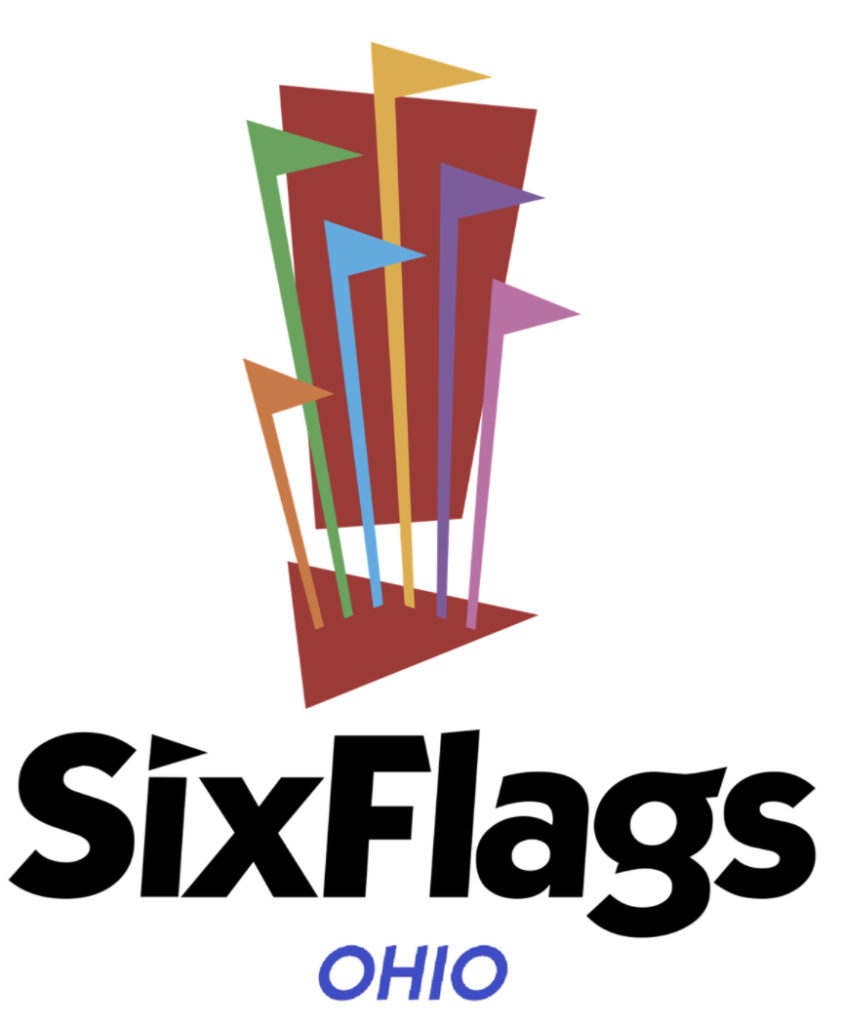
In 2000 – the park’s 112th season – the no-longer-quite-so-little amusement park on the western shore of Geauga Lake was renamed SIX FLAGS OHIO. Despite the perception among the public, the park hadn’t really changed hands or been “sold” to Six Flags. Quite the contrary, it had the same owner that had been supercharging the park’s thrill lineup since 1995, who had merely renamed itself and its existing parks after its landmark corporate purchase.
But for many, it’s hard to count anything but the New Millennium “transformation” into Six Flags Ohio as the start of the weirdest story in amusement park history. After all, Premier (remember, now merely renamed Six Flags) continued its radical reinvention of Aurora’s little family park.
In 2000 alone, Six Flags Ohio was granted $40 million in capital expenditure, adding 20 new rides including four – yes, four – roller coasters. The Roadrunner Express family coaster came to the park’s Western-stylized Coyote Creek. So did The Villain – a 108-foot tall out-and-back coaster tearing through 3,980 feet of rumbling wooden track.
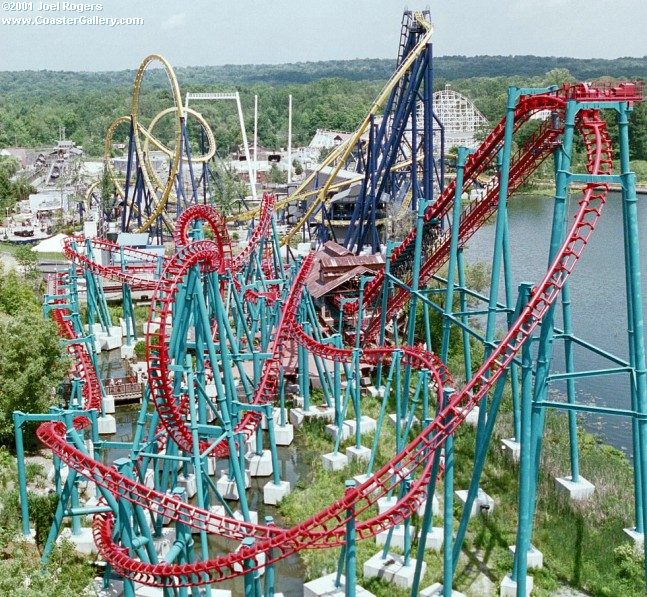
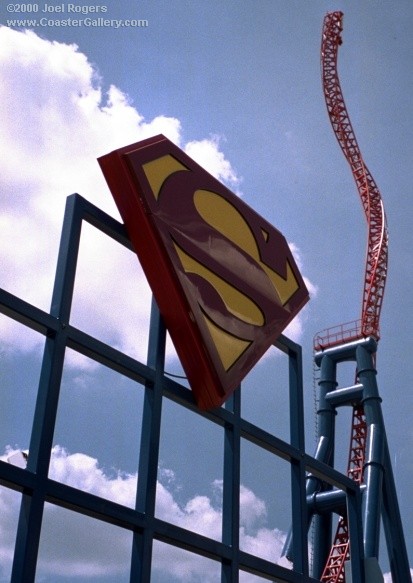
On the park’s lakefront, the Serial Thriller Vekoma suspended coaster was joined by Batman: Knight Flight, a 157-foot tall blue and yellow B&M Floorless coaster. A new anchor attraction for the park, Knight Flight careened through five inversions including the world’s tallest (a 135-foot-tall vertical loop), a cobra roll, and interlocking corkscrews. The park’s ’50s Midway area gained the fourth new coaster for the year: the patriotic red and blue steel of Superman: Ultimate Escape, an Intamin Impulse coaster running parallel to Aurora’s Route 43 – its twisted spike tower rising over the park’s entrance.
That same year, the construction of a new wave pool turned the former pool’s footprint into Looney Tunes Boomtown. The lakefront children’s area served as a home for Bugs Bunny, Daffy Duck, and the various other cartoon characters who also came along with Time Warner’s Six Flags package. For longtime guests, it might’ve seemed odd to see the Looney Tunes and DC Heroes coexisting with Geauga Lake’s historic ballrooms, Raging Wolf Bobs, and the Big Dipper, but for Millennials, this was their hometown park, emboldened; one transformed by Technicolor, now supersaturated with heroes, thrills, cartoon characters, and the kind of energy, excitement, and brash thrills that came along with Six Flags.
In other words, the single off-season between 1999 and 2000 (slide to compare, above) had made clear what Premier would make of Geauga Lake, and that as “Six Flags Ohio,” the park’s artificial inflation had a singular purpose: to turn Aurora’s little family park into a flagship that could even compete against Cedar Point – the “Roller Coaster Capital of the World” itself… There was only one thing that could make the transformation complete…
SeaWorld Adventure Park
Across the lake from the increasingly-steel skyline of Six Flags Ohio, SeaWorld had undergone a metamorphosis at the hands of its own new ownership…
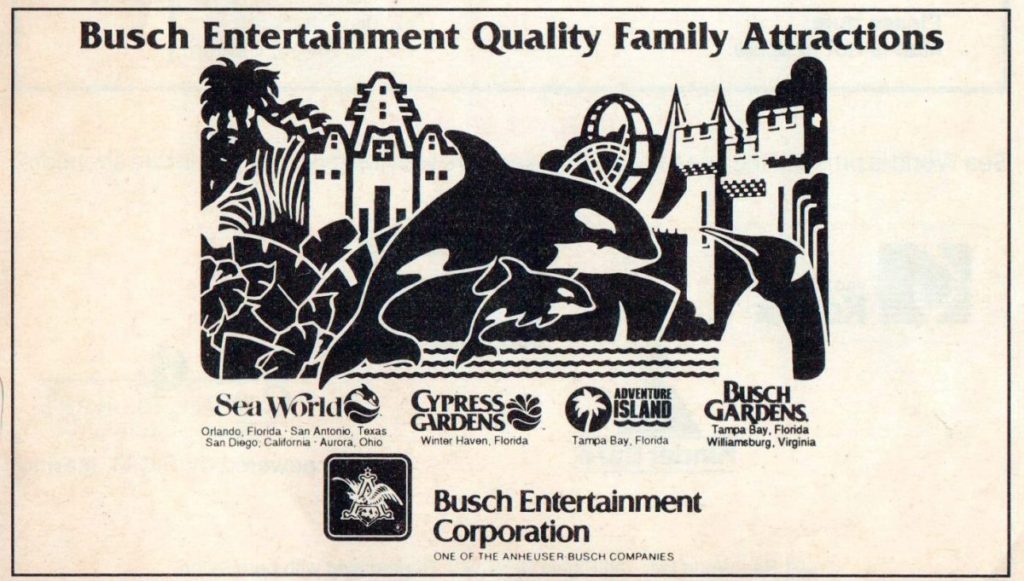
In 1989, the four SeaWorld parks (in San Diego, Aurora, Orlando, and San Antonio) were purchased by the American brewing company Anheuser-Busch for $1.1 billion. Ohio’s little family park now belonged to an international beverage distributor who saw their new parks as in-roads to regional and even national tourism.
The freshly-assembled Busch Entertainment Corporation had every reason to see SeaWorld as a pop culture coup given the brand’s sterling reputation with families. But more to the point, owning SeaWorld gave Busch a battlefront in the raging war for tourists in Southern California, Orlando, and even the increasingly-corporate flagship parks of Ohio.
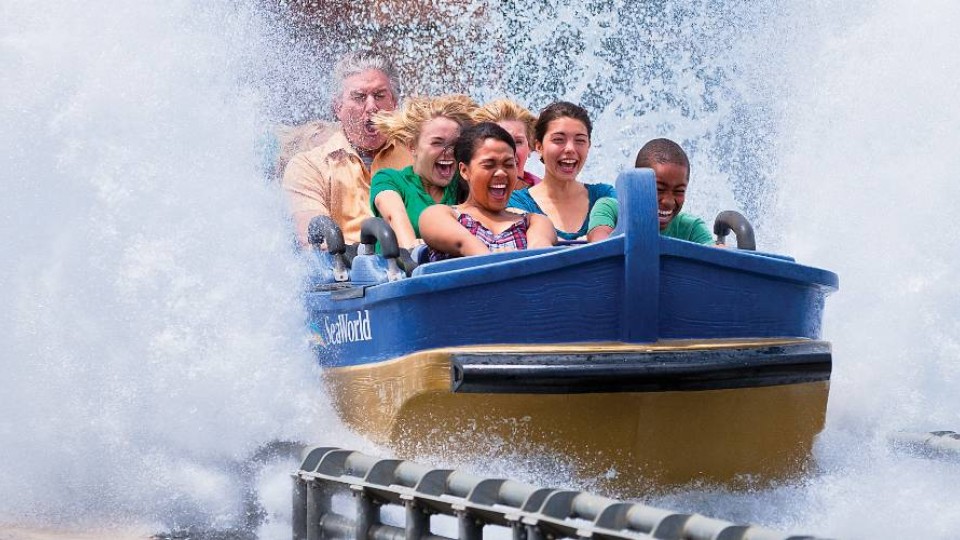
After Busch’s acquisition, the four SeaWorld parks spent the ’90s in a slow and steady transformation from mere zoological marine parks into destinations marked by legitimate rides tuned to the competition in their regions. In both Orlando (1992) and San Diego (1994), the additions of a simulator (Mission: Bermuda Triangle) put SeaWorld toe-to-toe with Disney’s then-new Lost Legend: STAR TOURS, unbelievably matching the cutting edge ride systems otherwise exclusive to the Disney-MGM Studios and Disneyland.
In Texas, 1997’s B&M inverted coaster Great White and 1999’s Morgan hypercoaster Steel Eel redefined the park’s skyline and competition with Six Flags Fiesta Texas just 15 minutes away. Meanwhile, San Diego’s Shipwreck Rapids in 1999 proved that the highly-restricted seaside park could squeeze in thematic environments and high thrill experiences.
Naturally, SeaWorld Orlando bet big on the “Adventure Park” concept’s ability to fuse thrills and theme, using 1998’s Declassified Disaster: Journey to Atlantis and 2000’s Kraken as a one-two punch of mythological adventures signaling that a SeaWorld of the 21st century could potentially be a nautical match for Disney’s storytelling and Universal’s thrills.
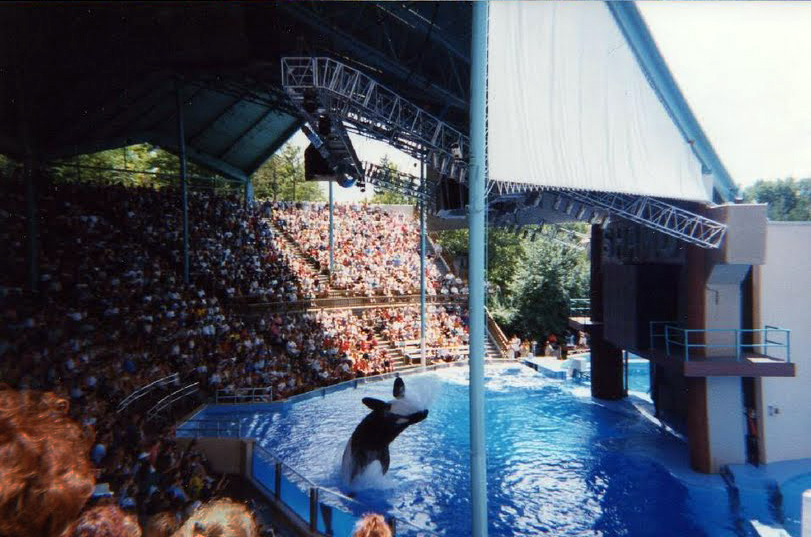
Back in Ohio, a taste of that transformation was at work… In 1992, the park opened the atmospheric special effects walkthrough Monster Marsh (later reimagined as Carnivore Park thanks to dinosaur animatronics). The immersive, atmosphere Shark Encounter and Dolphin Cove attractions opened in 1993 and 1995, each elevated well beyond mere “zoo exhibits.” In 1997, Pirates 4D opened in the custom-built Harbor Theater.
In 1999 – just as Geauga Lake was preparing to reintroduce itself as Six Flags Ohio a thousand feet away – SeaWorld underwent its own renaming. As part of Busch Entertainment’s larger reimagining of the chain, a new SEAWORLD ADVENTURE PARK CLEVELAND identity was rolled out. But unlike its sisters in California, Florida, and Texas, the new, adventurous branding did not signal the arrival of roller coasters, raft rides, or thrills.
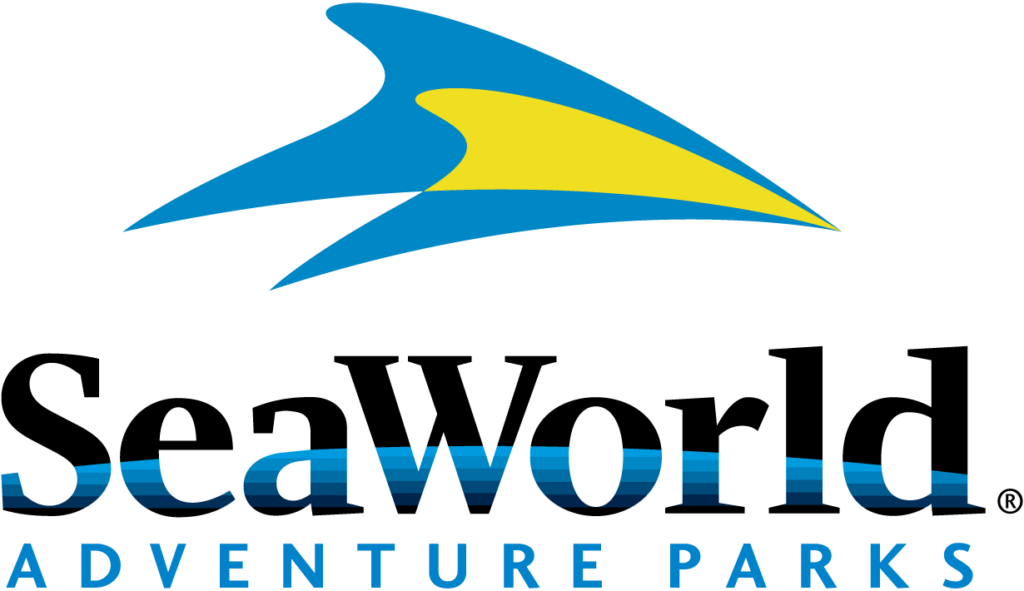
“We’re now considered an adventure park rather than just a marine life park,” said the park’s then-spokesperson, Kim Stover. But Stover was also quick to assert that due to “an agreement” with Geauga Lake prohibiting the park from building thrill rides, the kinds of log flumes, dark rides, raft rides, and roller coasters spreading to other SeaWorld parks would not make their way to Busch’s Cleveland park anytime soon…
Instead, in 2000, SeaWorld Cleveland would finally get the kind of attraction that had kicked off the “Adventure Parks” growth spurt at its sister parks a decade before: a simulator. Stover said of the addition, “It’s probably as close to a ride as we will come. It will add a new dimension to what we offer here, but I don’t think it’s going to radically change the direction. I don’t see roller coasters in our near future.” She added that the simulator “definitely was discussed with Geauga Lake.”
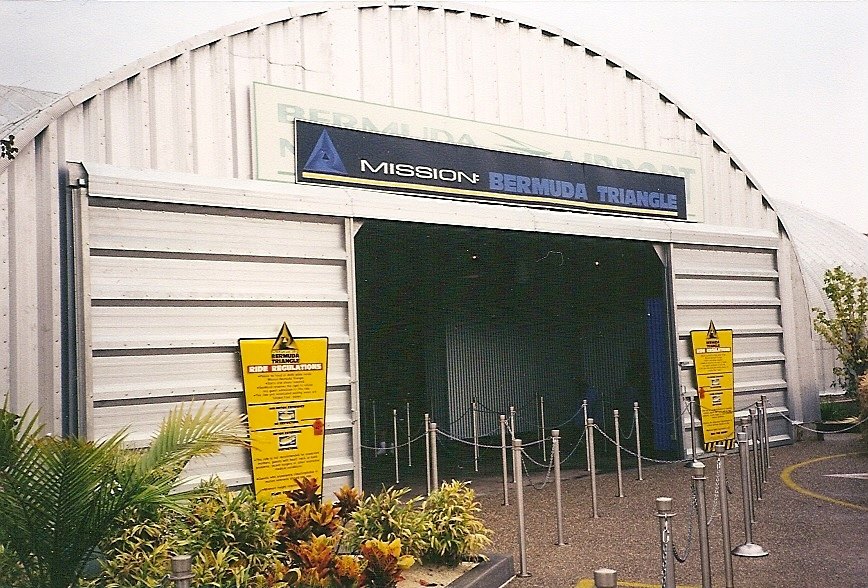
In 2000 – the same season its neighbor debuted its Six Flags rebrand – SeaWorld Cleveland opened Mission: Bermuda Triangle. Passing through a tropical Bermuda airport’s runway littered with wrecked plans, guests would enter a steel Quonset hut. There, they’d be briefed on their secret mission to explore the otherworldly anomalies of the mysterious region of the Atlantic, boarding the S.S.N. Neptune for an action-packed deep sea adventure past coral reefs, sharks, and shipwrecks.
The park’s then-PR director Kent Arwood said of the addition, “It’s a huge investment for the park. It will be the only attraction of its kind in this part of the country.” He was right. Though it came two decades after Star Tours, eight years after Orlando’s Mission: Bermuda Triangle, and (weirdly) six years after Orlando and San Diego’s simulators had already been “upgraded” to Wild Arctic, the addition of such a well-appointed, themed experience in a seasonal park in Northeast Ohio was a pretty big coup.

Unfortunately for SeaWorld Ohio, Mission: Bermuda Triangle was the equivalent of bringing pennies to a poker game.
Aside from Six Flags Ohio’s attention-grabbing addition of four headlining coasters, the 2000 season saw Cedar Point break steel coaster records with the tallest and fastest roller coaster ever – the Modern Marvel: Millennium Force – while across the state, Paramount’s Kings Island shattered wood coaster statistics with the world’s tallest, fastest, and only looping wooden coaster – the subject of our in-depth Declassified Disaster: Son of Beast.
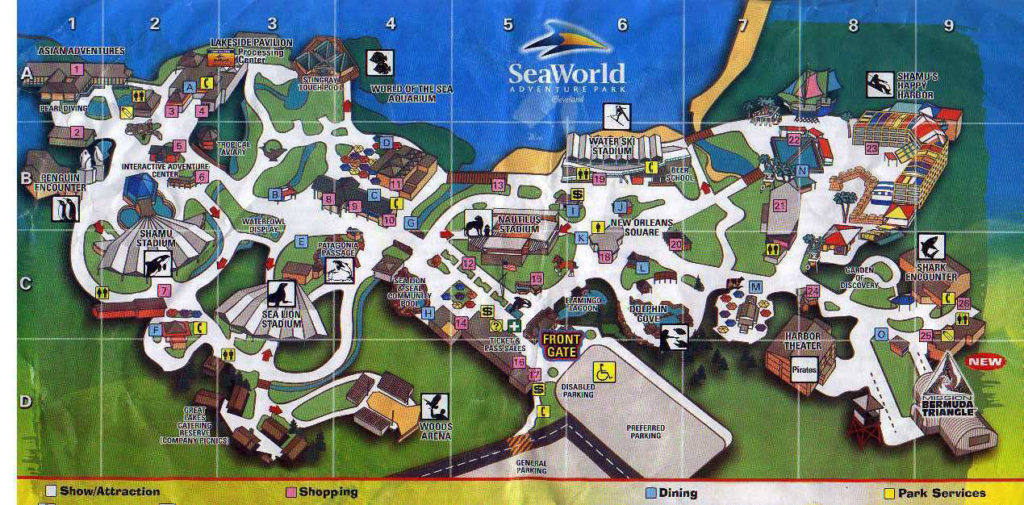
While Busch Entertainment was supercharging all of its other parks with the armaments they’d need to survive the era’s regional park “Coaster Wars,” SeaWorld Cleveland was beached. Thanks to its limited season and a non-compete agreement with Geauga Lake (then, Six Flags Ohio) the park stood little chance to compete or grow.
But Busch Entertainment had a plan…
An Offer You Can’t Refuse (2001)
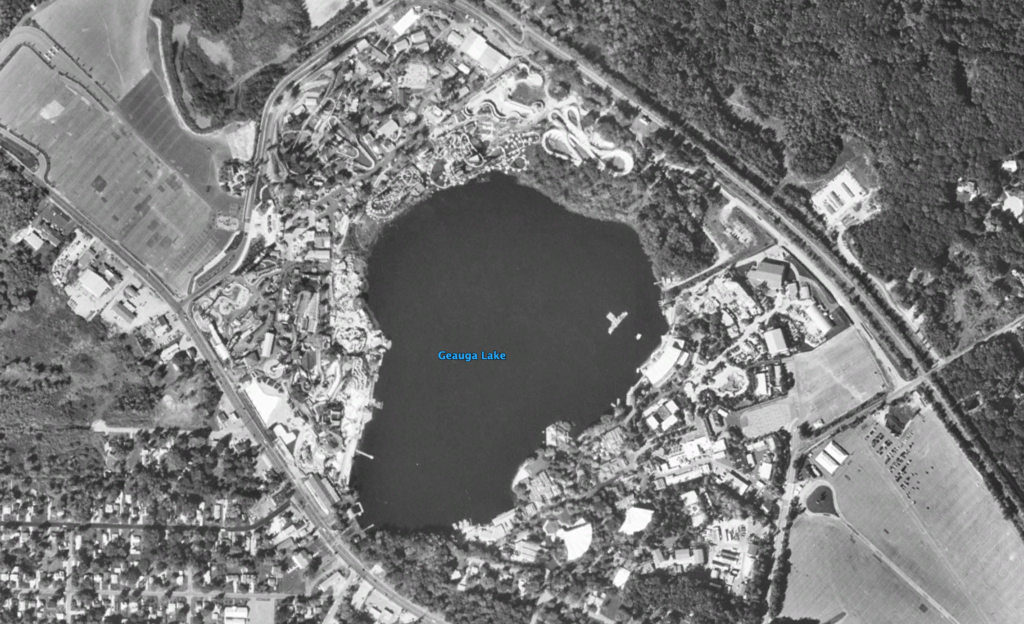
Though it officially dated back to 1887, for as long as most guests could remember the little family amusement park on the western shore of Geauga Lake was only half the story. The clamshell stadiums of SeaWorld served as a backdrop to a day at Geauga Lake; the roller coasters of Geauga Lake as distant beacons to families at SeaWorld.
And now, the New Millennium had seen both parks commandeered by global brands in their individual pursuits. Suddenly, the small town family park was a rapidly-expanding Six Flags with dreams of Cedar Point domination; SeaWorld, a would-be “Adventure Park” whose ambitions were hampered by their friend-turned-ruthless-competitor across the lake. Two increasingly full-sized, corporate parks whose co-marketing and complementary ticket deals were ancient history.
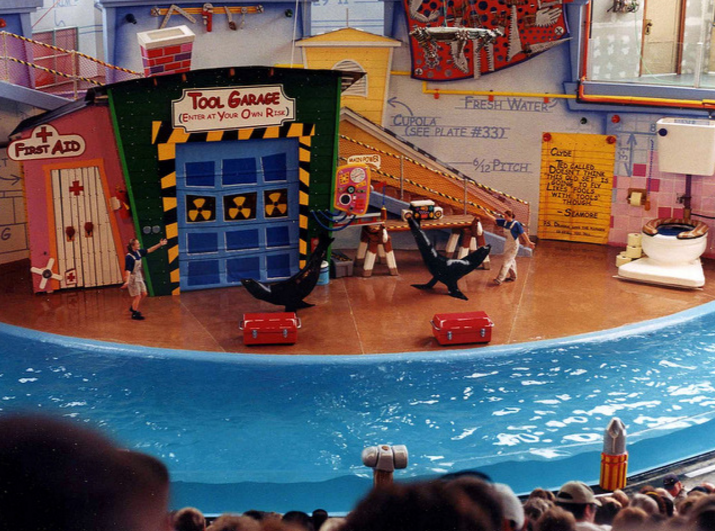
As the story goes, SeaWorld made the first move. In 2000, the Busch Entertainment Corporation allegedly contacted Six Flags Inc. with an unexpected offer: they wanted to purchase the newly-minted Six Flags Ohio. While no one can be certain, it’s possible that if the deal had gone through, the amusement park would’ve undergone its third name change in three years, perhaps reverting to “Geauga Lake” or even joining Busch Entertainment’s portfolio as “Busch Gardens Cleveland.”
That, of course, would’ve given Busch control of both gated parks around Geauga Lake, creating a resort all their own. Just as importantly, though, it would’ve nullified any non-compete agreement, allowing Ohio’s SeaWorld to grow just as its sisters had. (It’s fun to imagine, for example, that Busch ownership of both parks might’ve seen some of the ride park’s coasters and flat rides relocated across the lake, rebranded with SeaWorld names and re-balancing the two parks’ offerings. Couldn’t the twisted towers of “Superman: Ultimate Escape” have been relocated to the marine park and renamed “Electric Eel”, for example?)
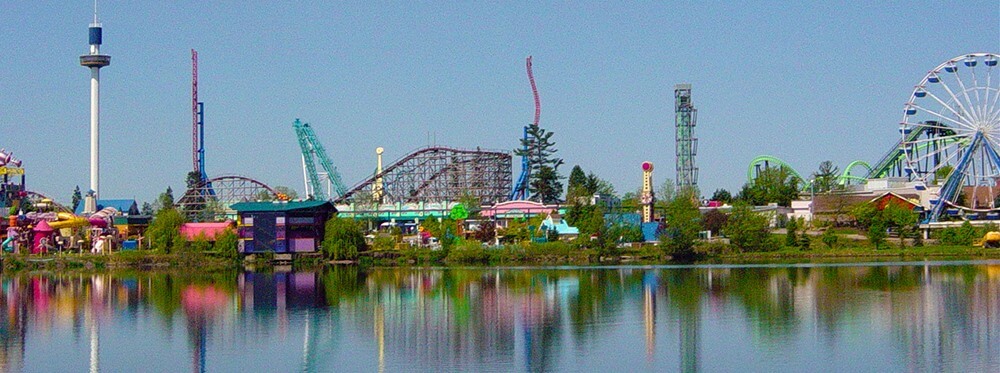
No doubt, the story of SeaWorld buying a neighboring Six Flags and renaming it Busch Gardens would’ve been one of the strangest stories in amusement park history. But what actually happened is even weirder. Declining Busch’s offer, the voracious Six Flags Inc. reportedly countered with an offer of its own.
On January 10, 2001 – while Six Flags Ohio slept under a blanket of lake effect snow – Six Flags Inc. officially added another park to its lineup: SeaWorld Ohio. For a premium of $110 million, SeaWorld took its killer whales, dolphins, and trademarks and left town. In the middle of the off-season, Six Flags repopulated much the park’s missing marine life (mostly by borrowing from Six Flags Marine World; today, Discovery Kingdom) and did the unthinkable…



What a fantastic place! Wish it was still there. It just doesn’t make sense. Combined the two parks should of been a must visit destination for people nationwide. A huge loss for Northeast Ohio.
I grew up not far from Geauga Lake on Pettibone Road in Solon, Ohio. We rode our bikes to the park in the 1940’s. We often got in with various companies employee days as they just thought we were kids who belonged to the group.
My memories of the early years were frozen custard, the bug, the 4th of July fireworks on the lake that my parents would bring us to see and I was scared to death! The swing ride that seemed yo spin you over the lake!
Living out in the country, a rural area, with the ability to go to such a fun place so easily was quite wonderful!
In the evening my parents would take us there and it seemed far different at night than in the daytime. I loved the roller coaster and would ride over and over again.
Now forward to my early teens….1948…on. The roller rink. I skated almost every night in the summer. What could be better than an open air roller rink on a lake with a live organist playing music to skate to all evening! It was wonderful as dance roller skating was very popular.
Later the rink burned down and I was heartbroken as I had spent so many happy hours there.
As a summer job when I was in college ( graduated high school in 1952) I was a lifeguard at the Lake….I also lifeguarded at the pool in Geauga Lake but I much preferred the job at the beach.
My story is before all the changes that made it into a huge attraction but I loved the years it was just a wonderful small beautiful park.
BTW I have never found frozen custard as good as that at Geauga Lake and there was no other roller skating rink with solid wood floors, an organist , and the breezes coming off the lake on hot summer nights in Ohio!
Elaine Kertes Clabeaux
eac@pacbell.net
Was chosen to be “kissed” by Shamu in 1972!
My boyfriend and I now my husband) use to go to the park and Sea World when we were 17 years old. Sitting in the wooden bleachers at the time, when the performer came up to the stands to choose a person, my boyfriend was pointing at me! Down by where Shamu was in the pool, she said for me bend sideways over the pool, Shamu came out of the water and touched the side of my face! Memories! Wish I still had the picture they took with their Polaroid camera!
I’m 81 and my siblings are all deceased so I can’t ask them. Do any of you remember little overnight cottages you could rent and stay at being there? This was in the 40’s and I have a vague memory. Thx
I grew up across the street from Geauga Lake in the neighborhood across the street. I grew up there and I hated the way they closed down. We had a pass where we could swim in the lake. I miss that amusement park.😢
I still miss the Geauga Lake of the 80’s. I have so many memories from Dad’s company picnics, to wading in The Wave (the original) anticipating the big wave action, to meeting my first love while in line to ride the Raging Wolf Bobs! It almost makes me cry.
I really enjoyed this. Thank you for posting about it on Strange and Hidden. I have memories of GL of course and SW growing up (my first coaster was the Double Loop in the 70’s), taking my kids there, and then seeing it die. I saw the mold in the bubble gum vending machine as my friends’ family and mine climbed the steps to the monorail. I mourned the loss of the Rotor–which was my favorite ride. I got to ride it once about 23 times or more in a row because no one was in line. There was a man that stayed in it all day long that I recall. So many memories of Aurora and cutting through the traffic by heading east from Route 8 and cheating at the stop light with my ex in the 90’s. And somewhere, I have a penny that was stretched and stamped in 1996.
My memories stretch across 5 decades.